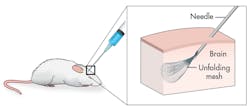Harvard scientists have come up with a rather electrifying way to monitor brain cells (click here to read the full paper in Nature Journal). They expect that the technology will give neurologists a minimally invasive way to understand exactly how the brain works, or stimulate the right neurons in the brain to reverse brain damage.
A silk mesh seeded with nanoscale electrodes and transistors curls up into a 100-micrometer-diameter needle with a phosphate-buffered saline (PBS) solution for easy injection. Then, using a mouse as a test subject, the mesh unfurled as it was injected into the brain tissue.
The netting is soft with smoothly integrated electronic components to cover the brain’s surface without damaging it, and as proven in an in vitro experiment in 2012, the netting integrates with brain cells. It’s flexibility enables it to move with the brain’s dynamic interface. In the in vivo trial, the team only monitored the mesh for five weeks, so testing still must be done regarding long-term compatibility with the brain.
The tested mesh consists of only 16 electrical elements, all capable of monitoring and stimulating individual neurons. Input and output signals are transmitted from protruding wires. A gelatin-based needle that can be used for injecting electrodes into the brain is a contender for future trials. Ideally, in future research, the scientists would like to design a wireless transmission system that would also be less intrusive.
As the technology improves, scientists hope to record synapsis paths of complex neural systems during different brain functions. If successful, they will have empirical data about neuronal pathways during passive thinking and hard concentration, activity after a stroke, or what goes on in a degrading brain of an Alzheimer patient.
The technology will give rise to more accurate artificial intelligence, a better understanding of brain diseases and function, as well as synapse patterns for different emotions or ways of thinking.

